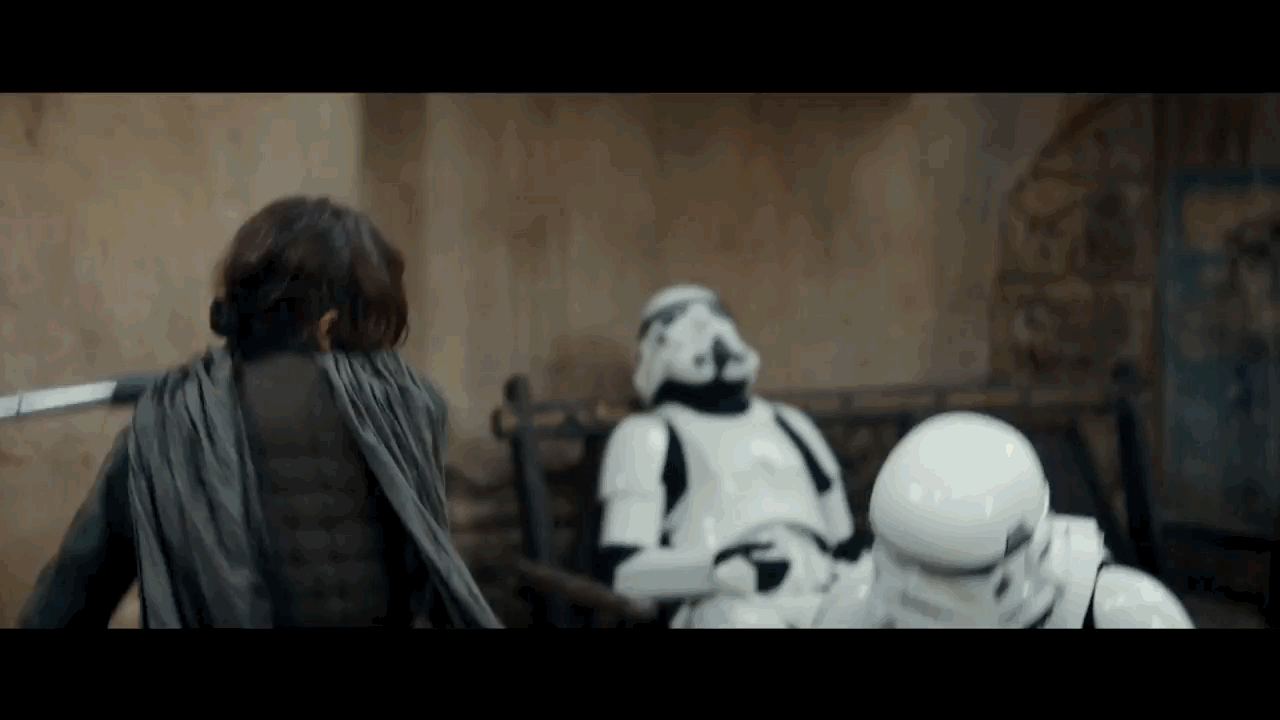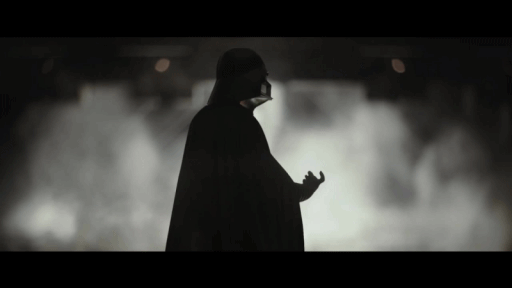It was an ambitious move for Disney: making an entire movie about the heretofor unidentified Rebel agents who stole the plans for the Death Star immediately prior to the events of 1977’s Star Wars: A New Hope. How would audiences feel about going back over old ground, especially in the wake of the movie series’s successful cinematic relaunch with 2015’s The Force Awakens? With Rogue One: A Star Wars Story now second only to its 2015 predecessor in terms of December opening figures it is safe to say that tales of life before the Galactic Empire’s fall are still a hit with viewers. But what does Rogue One do for the series as a whole? Does it strengthen George Lucas’s science fiction universe beyond just giving fans another two hours to kill there? The answer is, more than you’d think.
Sure there’s the obvious benefit of finally resolving a question that has been hotly debated everywhere from internet chat rooms to episodes of Family Guy: the question of why would the Empire put all their money on the Death Star if they knew it had such an obvious weakness. (The short SPOILERY answer: they didn’t.) But Rogue One repairs other glaring errors in the Star Wars status quo that have been in desperate need of it. Here is a sampling.
1) It finally puts the “Wars” in Star Wars.

Despite having “war” in all their titles, the Star Wars films have never really been war movies. They’ve all been dedicated to the exploits of a swashbuckling band of three or four heroes set against the backdrop of a war. Even the epic space battles are really just there to emphasize the heroes’ barnstorming flight skills while hapless extras get blown up around them.
Rogue One feels like a war movie. There are no larger-than-life Jedi here to fulfill ancient prophecies or redeem wicked hearts. The closest thing to that is Donnie Yen’s blind priest character who, while Force-sensitive enough to hold his own against Stormtroopers, isn’t going to change the fate of the galaxy on his own and he knows it. No, this is a movie about ordinary men and women doing a dirty job that requires them to lay down their lives more often than not. They know that no supernatural power is coming to save them and that themselves and each other is all they’ve got to rely upon.

Speaking of Stormtroopers, they are still there to die in droves. Their armor is as useless as ever and they make terminally bad decisions in combat as always. But their Rebel opponents turn out to be no less vulnerable than they. The climactic battle of the film is ugly and unhappy, and once the Stormtroopers finally start killing people off, they really get down into it. It’s not groundbreaking as war movies go, but at least it feels like an effort is being made to show war as something other than glorious fun, clever one-liners, and dashing heroics.
2) It finally puts the “stars” in Star Wars

The inability to create a sense of scope is a common problem in science fiction films and Star Wars is no exception. Given that so many science fiction films draw inspiration from Star Wars it’s easy to see why it’s a common problem. Galaxies are hundreds of thousands of light years across, after all, and how do you capture the scale of that while keeping a story focused on a handful of characters? A definitive answer is elusive, but it feels like Rogue One really does try to make the conflict between the Empire and the Rebel Alliance feel bigger than previous movies in the franchise have. It does this by visiting more planets in just one movie than the entire original trilogy did across all three of its components!
With the exception of Rebel-occupied Yavin-4, all of these planets are suffering under Imperial rule, too. The desert planet of Jehda is having its holy sites pillaged while terrorists cause havoc in the streets. Grey Wobani and rain-soaked Eadhu both essentially serve as prisons of different kinds. Even lush, tropical Scarif is overwhelmed by the energy shield the Empire has encased it in to protect the Imperial archives there. We even get a return visit to Mustafar where Darth Vader was famously maimed in Revenge of the Sith and where he has now made a frightening home dedicated to the Dark Side. Even tranquil Lah’mu has its peace marred by Imperial Troops and serves as the place where future heroine Jyn Erso has her childhood shattered. It’s a hurried trip through a big galaxy and the Empire has got its jackboots all over it. Rogue One gives us a look at what the Empire does when left to its own devices that the original trilogy doesn’t and makes a case for why they need to be stopped other than just “They blow up planets and there’s this one guy who chokes people.”
3) Finally, some moral ambiguity.

Star Wars is an iconic, awe-inspiring tale of good triumphing over evil. This is both its greatest strength and its greatest weakness. In war good people can display cruelty and cowardice while wicked people display compassion and valor. Star Wars has never concerned itself with such complications. The Rebel Alliance have always been unsullied good guys, beyond reproach. The most morally ambiguous guy they’ve got on their side is Han Solo and the closest thing to an immoral act that we ever actually saw him commit got retconned! This uncritical portrayal actually undermines the Alliance in the eyes of many fans as it implies a frightening lack of concern for everything from the potential aftermath of blowing up a Death Star directly above Endor to the lives of innocent building contractors. The Empire don’t get a much more nuanced portrayal either, and why would they? After all, aren’t they just legions of bumbling stooges for a couple of semi-openly-practicing Sith Lords?

Rogue One puts paid to all that. For the first time we get to see the Alliance leaders do something other than briefly tell Luke and Han where to fly their ships to and it isn’t pretty. Indeed, by the time our heroes figure out that the Death Star is vulnerable the Rebel Alliance is on the brink of dissolving. There are cowards and murderers within its ranks, and different factions with conflicting agendas and varying levels of regard for innocent lives. By the time of the Death Star’s completion a splinter sect of Rebels has even formed under the leadership of Saw Guerrera (Forest Whittaker). Gerrera is dubbed an extremist by the Alliance proper and he certainly lives up to it, thinking nothing of waging brutal terrorist warfare in the heart of a civilian population center or psychically torturing prisoners to the point of insanity.
The Empire put up a more unified front, but one of the film’s most interesting characters is Bodhi Rook (Riz Ahmed): an Imperial pilot who has gotten fed up with the Empire’s excesses and has decided to defect. His skills and inside knowledge not only make him a valuable asset to the Alliance, but his continued vehemence about leaving the Empire indicates that not all is well within the Imperial ranks. The same can be said of Galen Erso (Mads Mikkelsen), and if the man who created the Death Star in the first place can get fed up with the regime he serves, then how many others under Imperial command feel the same way?
For all that, the lines in Rogue One are still clearly drawn. The Rebel Alliance have their problems but they’re still good. The Empire has its conscientious objectors but they’re still overwhelmingly bad. But the effort to instill a little more realism into the two sides of the conflict breathes new life into Star Wars’ timeless tale.
Speaking of the overwhelmingly bad…
4) Darth Vader is finally terrifying.

Darth Vader is quite possibly the most recognizable and iconic movie bad guy of all time. A horrific merging of flesh and machine, a fallen hero, an accomplice in genocide, a failure as a husband and father: the guy is just all the hate and darkness you can imagine bottled up into a black suit of armor. But he’s also the “face” of the Star Wars brand; an advertising mascot. And that can take a serious toll on any villain’s street cred. Selling all those toys comes at the cost of doing things no villain ever thinks they’d do.

Yeah.
Rogue One slaps us back in line, however, and in his few brief, disturbing scenes Vader reminds us he’s not to be treated as a joke. On Mustafar we are painfully reminded of his existence as a disfigured, perpetually-dying cyborg in a scene both tragic and intimidating. But the real gem comes just minutes before the end of the film.
*SPOILER ALERT*

While the beleagured Rebels are literally dying to get the stolen Death Star plans into the hands of Princess Leia, Vader appears and he just turns into a lightsaber-wielding killdozer, slaughtering about thirty guys in as many seconds. As the camera peers into the darkness you know just who is going to emerge, but when that red lightsaber burns into existence you know it’s going to be brutal all the same. Vader engages in utter carnage like we have just never seen from him in the movies. He kicks so much ass in such a short amount of time that his boast from A New Hope that the Death Star is nothing compared to the Force finally makes sense. It all ties back into the theme of making the Empire appear to be a darker, more serious threat and to this end Vader’s small amount of screen time is used incredibly well. It also makes the stakes that much higher for our Force-deficient heroes who just want to create a better world and are doing so at the cost of their own conscience.
It’s definitely an incarnation of the fallen Anakin Skywalker that the Star Wars franchise could stand to show us more of. Whether they do so or not in future installments is simply unknown at this time.

We fell your pain, big guy. We feel your pain.

